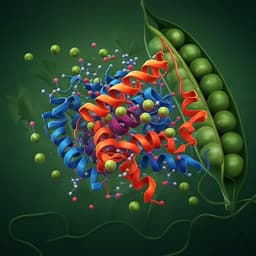
Engineering and Technology
On-chip parallel processing of quantum frequency comb
L. Zhang, C. Cui, et al.
Discover groundbreaking advancements in quantum information processing with an integrated photonic platform for generating and parallel processing quantum frequency combs. This innovative research, conducted by Liang Zhang, Chaohan Cui, Jianchang Yan, Yanan Guo, Junxi Wang, and Linran Fan, showcases simultaneous on-chip quantum interference and reconfiguration of frequency modes, paving the way for efficient applications in integrated photonics.
~3 min • Beginner • English
Introduction
The study investigates how to efficiently generate and process high-dimensional photonic entanglement using the frequency degree of freedom on an integrated chip. High-dimensional systems promise stronger tests of quantum theory, improved error resilience in computing, and higher-capacity, more robust communications. While various photonic degrees of freedom (path, OAM, spatial, temporal) have been used, frequency modes are particularly amenable to integrated implementation because they avoid the need for ultra-long delays or highly multimode waveguides. Prior integrated biphoton quantum frequency combs (QFCs) have mostly relied on spontaneous four-wave mixing with discrete off-chip processing components, which limits scalability. It is advantageous to leverage second-order nonlinearity for higher power efficiency. The purpose of this work is to demonstrate an integrated aluminum nitride (AlN) platform that can both generate QFCs with near-identical spectra in two counter-propagating paths and perform parallel, high-visibility on-chip quantum interference and reconfiguration across many frequency modes, culminating in deterministic separation and high-dimensional Hong–Ou–Mandel (HOM) interference.
Literature Review
Previous work established high-dimensional entanglement in various photonic degrees of freedom and generated integrated QFCs via spontaneous four-wave mixing, enabling WDM quantum communications and coherent superposition of frequency modes (e.g., Reimer 2016; Jaramillo-Villegas 2017; Kues 2017). However, those implementations often depend on discrete, off-chip components for manipulation and have not exploited second-order nonlinearity’s higher efficiency. Frequency-mode quantum operations have been demonstrated using free-space and fiber-based components, and comprehensive on-chip unitary control over frequency modes has been discussed conceptually using programmable filters and active modulators. The present work addresses these gaps by demonstrating on-chip parallel processing of QFCs using a χ(2) AlN platform and Sagnac-enhanced parametric down-conversion, maintaining mode-independent interference properties and enabling deterministic path separation without spectral filtering.
Methodology
Platform and device: An integrated AlN photonic platform implements cavity-enhanced parametric down-conversion (PDC) in a ring cavity within a Sagnac configuration. A CW pump near 775 nm is split by a Y-junction and coupled into the ring in clockwise (CW) and counter-clockwise (CCW) directions. The AlN χ(2) nonlinearity and broad phase-matching generate telecom-wavelength biphoton pairs across multiple cavity resonances, forming QFCs with symmetric frequency bins about the degenerate wavelength (1555.68 nm). Identical spectral distributions for CW and CCW are ensured by using the same cavity in both directions. A thermo-optic on-chip phase shifter controls the relative phase between paths, and a balanced multimode interferometer/50:50 beamsplitter effects interference and state reconfiguration.
Measurement setup: Calibration waveguides extract QFCs from both CW and CCW outputs. Long-pass filters remove pump light, and narrow tunable filters or programmable filters select specific resonances or groups of resonances. Photons are detected by SNSPDs. Frequency correlations are measured within each path and across paths using two or four detector channels as needed. Coincidence-to-accidental ratios (CAR) and visibility are obtained without background subtraction. The Schmidt number lower bound is estimated via Schmidt decomposition of the frequency correlation matrix. Temporal self-correlation g^(2)(0) is measured with a Hanbury-Brown–Twiss setup to estimate the number of resonance pairs; g^(2)(0) increases with the number of modes, yielding a linear relation with resonance-pair count inferred from filter bandwidth. A calibration Mach–Zehnder interferometer with the same phase shifter and beamsplitter provides a classical interference reference.
Parallel quantum interference: The phase shifter tunes the relative phase φ between CW and CCW QFCs; self-correlation S_kk and cross-correlation C_{k,-k} are recorded versus φ for k=0 (degenerate) and higher-order symmetric bins (e.g., k=4), as well as collectively for k=0–4. Quantum interference shows a 2φ phase response (NOON-like) with S_00 ∝ cos^2φ and C_{0,0} ∝ sin^2φ, contrasted with classical phase φ. Wavelength-dependent dispersion shifts seen in classical interference are suppressed in the quantum case due to fixed sum frequency; interference patterns are uniform across resonance pairs, enabling parallel processing with identical phase-shifter settings.
High-dimensional HOM experiment: With φ=π/2 (anti-bunching), deterministic separation is achieved. A tunable optical delay line introduces relative time delay, polarization is matched with a fiber polarization controller, and a balanced fiber beamsplitter combines the paths for HOM interference. Programmable filters select either the degenerate resonance alone or the first five resonance pairs (k=0–4). The HOM dip for the single degenerate resonance provides the reference envelope; with multiple resonances, fast oscillations and periodic revivals reflect inter-resonance beating and the cavity free spectral range.
Device fabrication and materials: AlN wafer growth on c-plane sapphire by MOCVD: 25 nm low-temperature AlN buffer at 550 °C followed by 1 µm high-quality AlN at 1200 °C. Photonic circuits are patterned via electron-beam lithography in FOX-16, transferred by RIE using Cl2/BCl3/Ar chemistry, clad with 2 µm PECVD SiO2, and integrated with Ti/Pt (5/200 nm) electrodes for thermo-optic phase shifters via photolithography and lift-off. Key cavity parameters inferred from measurements include free spectral range ≈362 GHz and resonance linewidth ≈623 MHz (consistent with HOM FWHM ~1.67 ns).
Key Findings
- Efficient on-chip generation of indistinguishable QFCs in CW and CCW directions using χ(2) PDC in an AlN ring within a Sagnac configuration. CW and CCW single-photon spectra match cavity resonances and each other.
- Average measured coincidence rate per resonance pair ≈7 kHz, implying ~2 MHz on-chip photon-pair generation rate.
- Strong spectral correlations only between symmetric frequency modes around 1555.68 nm; CAR > 25 dB for all resonance pairs.
- Lower bound on QFC dimensionality scales linearly with the number of resonance pairs; with 10 pairs, Schmidt number lower bound > 9.2.
- Temporal self-correlation g^(2)(0) confirms multi-resonance behavior and agrees linearly with the number of resonance pairs inferred from filter bandwidth.
- On-chip parallel quantum interference exhibits NOON-like 2φ phase dependence with high visibilities: degenerate pair visibility ~93.8% (no background subtraction); non-degenerate and multi-pair measurements maintain similarly high visibilities (typical >90%).
- Interference patterns and required phase-shifter drive power are uniform across different resonance pairs (e.g., k=4 matches k=0), enabling identical settings for all modes and demonstrating true parallel processing.
- Reconfigurable path–frequency correlations: φ=0 (bunching), φ=π/4 (coherent superposition), φ=π/2 (anti-bunching); at φ=π/2 photons are deterministically separated with no same-path correlations across resonance pairs.
- High-dimensional HOM interference: single degenerate resonance shows a single dip with visibility 89.6±2.5% and FWHM ~1.67 ns (consistent with 623 MHz linewidth). With five resonance pairs (k=0–4), fast oscillations and revival of dips with 1.4 ps period match the cavity FSR of ~362 GHz. Revivals at ~1.1 ns persist with reduced visibility, and narrow high-visibility dips near zero delay confirm intra-pair phase coherence.
Discussion
The work addresses the challenge of scalable, on-chip high-dimensional quantum information processing by exploiting the frequency degree of freedom in an integrated χ(2) AlN platform. Generating CW/CCW QFCs with near-identical spectra in a single ring cavity enables mode-independent, high-visibility two-photon interference across many frequency bins using the same circuit settings, evidencing nonlocal dispersion cancellation and robust parallelism. Deterministic separation (anti-bunching) without spectral filtering allows direct high-dimensional HOM interference and validates coherent control in both path and frequency domains. The demonstrated uniform response across frequency modes is critical for scaling frequency-encoded quantum processors. These results establish a foundation for on-chip reconfigurable, high-dimensional photonic entanglement processing, leveraging second-order nonlinearity for improved efficiency and opening pathways to full frequency-domain unitary control with integrated modulators and programmable filters.
Conclusion
An integrated AlN platform is demonstrated for the on-chip parallel processing of quantum frequency combs. Cavity-enhanced PDC in a Sagnac-configured ring yields indistinguishable CW/CCW QFCs, enabling simultaneous, high-visibility quantum interference and reconfigurable path–frequency correlations across multiple modes. Deterministic separation without spectral filtering allows high-dimensional HOM interference with features consistent with cavity linewidth and FSR. The approach can substantially increase the dimensionality and functionality of integrated quantum photonics. Future work should integrate coherent frequency operations (e.g., χ(2)/electro-optic phase modulation) and programmable spectral filtering on-chip to realize arbitrary unitary transformations over frequency modes, and scale path dimensionality using multiple ring cavities with post-fabrication spectral alignment and quantum frequency conversion.
Limitations
- Path-domain dimensionality is limited by the Sagnac configuration to two counter-propagating modes; expanding beyond two paths requires multiple ring cavities and precise spectral alignment.
- Fully integrated coherent frequency operations (active mixing/modulation and on-chip programmable filtering) were not implemented; demonstrations of inter-pair frequency coherence require active on-chip methods.
- The HOM measurements confirm intra-pair coherence but are not sufficient to establish inter-pair coherence; comprehensive frequency-domain tomography remains for future work.
- Reduced visibility observed in long-delay HOM revivals indicates residual imperfections (e.g., dispersion, loss imbalance, or phase noise) that could affect performance at large delays.
Related Publications
Explore these studies to deepen your understanding of the subject.







